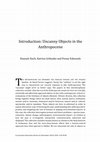Books by Hannah Stark
Australian Humanities Review, 2018
Journal Articles by Hannah Stark
Critique: Studies in Contemporary Fiction 60.2 , 2018
This article examines the complex and shifting appetites for meat and sex in Michel Faber's 2000 ... more This article examines the complex and shifting appetites for meat and sex in Michel Faber's 2000 novel Under the Skin and the 2013 Jonathan Glazer film adaptation of the book. Although almost unrecognizable at the level of plot, this article argues that considering these texts together highlights their deep and unsettling rendering of misogyny in relation to the pleasures and perils of consumption. In engaging with the confronting and, at times, politically ambiguous treatment of consumption in these texts, this article offers a reading of the intersectional relationship between the oppression of women in a patriarchal society and the exploitation of nonhuman animals as a resource for human endeavors.
Eco Culture: Disaster, Narrative Discourse. Robert Ficociello and Robert Bell (Eds). Lanham: Lexington., 2017
Parrhesia: A Journal of Critical Philosophy., 2019
Deleuze and Evolutionary Theory. Michael James Bennett and Tano S. Posteraro (Eds). Edinburgh: Edinburgh University Press., 2019
Austerity Gardens: The Poetics and Politics of Gardens in Hard Times, Naomi Milthorpe (Ed.). Lanham: Lexington., 2019
Deleuze and the Schizoanalysis of Feminism. Janae Sholtz and Cheri Carr (eds.) Bloomsbury, 2019
Australian Humanities Review, 2018

Australian Humanities Review, 2018
HE ANTHROPOCENE HAS RENDERED THE FAMILIAR STRANGE AND THE STRANGE familiar. As David Farrier sugg... more HE ANTHROPOCENE HAS RENDERED THE FAMILIAR STRANGE AND THE STRANGE familiar. As David Farrier suggests, 'Surely the "sublime" is not the right way to characterise our visceral response to [the Anthropocene]. The "uncanny" might serve us better' (np). The papers in this interdisciplinary collection consider what the era of the Anthropocene means for how we critically, artistically and affectively approach objects. In line with contemporary critical reevaluations of the liveliness of objects (Bennett, Vibrant; Brown), this collection brings together things which are dead and/or alive, human and/or nonhuman, sensate and/or insensate, fantastical and/or historical, natural and/or cultural, spectacular and/or mundane. These objects are here re-enlivened in order to expose alternative ways of knowing the past, understanding this anthropocentric present, and imagining the role of humans in shaping environmental futures. In this way, the collection interrogates present and future problems-species massextinction, climate change, anthropogenic environmental impact-in relation to how the past is re-imagined, interpreted, commemorated, subverted and displayed. The collection considers human history in relation to the deep histories of nonhuman time and the more-than-human effects that a human-centred approach have often ignored or hidden. We are interested not only in objects as T Australian Humanities Review (November 2018) 23 products of the Anthropocene, but in how the Anthropocene uncanny invites us to re-consider histories and objects in new and unexpected ways.

Twenty years after his death, Deleuze's thought continues to be mobilised in relation to the most... more Twenty years after his death, Deleuze's thought continues to be mobilised in relation to the most timely and critical problems society faces, foremost amongst which is the Anthropocene. What might the significance of Deleuze and Guattari be in relation to the new and urgent set of concerns that the Anthropocene engenders? Deleuze's work presaged much of the concept of the Anthropocene, not only in his sustained challenges to humanism, anthropocentrism and capitalism, but also through his interest in geology and the philosophy of time. Guattari gave his work an 'ecosophical' and 'cartographical' dimension and spoke of a 'mechanosphere' covering the planet. Together, Deleuze and Guattari advocated a 'geophilosophy' which called for a 'new earth' along with 'new peoples'. Not only does the work of Deleuze and Guattari offer a range of useful concepts that can be applied to contemporary global problems such as anthropogenic climate change, peak oil and the exploitation of the nonhuman, but it also models the kind of interdisciplinarity that the epoch of the Anthropocene requires. This special issue of Deleuze Studies engages the many philosophical tools provided by Deleuze and Guattari and their interlocutors in order to critically approach our particularly tense moment in terrestrial history. Simultaneously, it asks how this moment could change the ways in which Deleuze and Guattari are further developed.

The thylacine looms large in Tasmanian culture. The animal's image is everywhere, present on ever... more The thylacine looms large in Tasmanian culture. The animal's image is everywhere, present on everything from beer labels to licence plates. The documentary footage of the last thylacine in Hobart Zoo has come to exemplify, among other things, the tragedy of species loss and humanity's violence against the nonhuman. This footage features at the beginning of both The Hunter and Dying Breed -two of the very small number of films that constitute a notional Tasmanian cinema. In contrast to the meanings suggested by the documentary images of the last thylacine however, the fictional Tasmanian tiger in these films becomes a repository for those aspects of humanity that need to be expunged. In The Hunter, the thylacine's dead body is potential raw material for weapons production by a biotech company. In Dying Breed, the thylacine is aligned with a cannibalistic community -implicitly descendent from cannibal convict Alexander Pearce -who rape female tourists in order to perpetuate their kind. In these two texts the thylacine therefore symbolically embodies humanity's inhumanity, degeneracy, and monstrosity -qualities that The Hunter gestures towards wiping out through the eponymous hero's enactment of the thylacine's 'final' extinction. The narratives of The Hunter and Dying Breed assert man's right to violently determine survival and reproduction. These politics resonate with the thylacine's history both in terms of the significance of the hunt in her extinction and the confinement of the last thylacine in a zoo -an environment where reproduction is fully governed by humans.
Judith Butler's recent work is exemplary of the trend in contemporary theory to consider ethics. ... more Judith Butler's recent work is exemplary of the trend in contemporary theory to consider ethics. Her deliberation over ethical questions, and the place of ethics in intellectual work, has undeniably intensified since September 11. This article will demonstrate, however, that this is a rendering explicit of what has always been implicit in her work. Rather than perceiving the ethical dimension of Butler's writings in her increasing interest in thinkers such as Emmanuel Levinas and Hannah Arendt, I contend that it is in her sustained interest in Hegel, and specifically in Hegelian recognition, that her work can be read as engaged with ethical concerns. This article highlights the growing critical concern with the prevalence of recognition in ethical theory and questions the possibility of theorising ethics outside of the recognition-paradigm.










Uploads
Books by Hannah Stark
Journal Articles by Hannah Stark